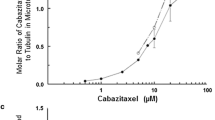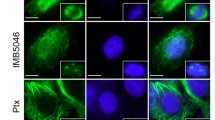Abstract
Ixabepilone (Ixempra, BMS-247550), a semisynthetic analog of epothilone B, is a microtubule-targeted drug in clinical use for treatment of metastatic or locally advanced breast cancer. Ixabepilone’s binding and mechanism of action on microtubules and their dynamics, as well as its interactions with isotypically altered microtubules, both in vitro and in tumor cells, have not been described. Microtubules are dynamic polymers of the protein tubulin that function in mitosis, intracellular transport, cell proliferation, and migration. They continually undergo dynamic instability, periods of slow growth and rapid shortening that are crucial to these cell functions. We determined ixabepilone’s microtubule binding and polymerization effects in vitro and also determined its effects on inhibition of dynamic instability in vitro and in cells, both with and without removal of the βIII isotype of tubulin. The βIII isotype of tubulin is associated with drug resistance and tumor aggressivity. We found that removal (in vitro) and knockdown (in cells) of βIII-tubulin led to increased inhibition of microtubule dynamic instability by ixabepilone. Depletion of βIII-tubulin from MCF7 human breast cancer cells also induced increased mitotic arrest by ixabepilone. Thus, βIII-tubulin expression suppresses the antitumor effects of ixabepilone, indicating that increased βIII-tubulin may be an important contributor to the development of resistance to ixabepilone.




Similar content being viewed by others
References
Cristofanilli M (2012) Advancements in the treatment of metastatic breast cancer (MBC): the role of ixabepilone. J Oncol 2012:703–858. doi:10.1155/2012/703858
Denduluri N, Swain S (2011) Ixabepilone: clinical role in metastatic breast cancer. Clin Breast Cancer 11:139–145
Brogdon CF, Lee FY, Canetta RM (2014) Development of other microtubule-stabilizer families: the epothilones and their derivatives. Anticancer Drugs 25:599–609. doi:10.1097/CAD.0000000000000071
Liu G, Chen YH, Dipaola R, Carducci M, Wilding G (2012) Phase II trial of weekly ixabepilone in men with metastatic castrate-resistant prostate cancer (E3803): a trial of the Eastern Cooperative Oncology Group. Clin Genitourin Cancer 10:99–105. doi:10.1016/j.clgc.2012.01.009
Smaglo BG, Pishvaian MJ (2014) Profile and potential of ixabepilone in the treatment of pancreatic cancer. Drug Des Dev Ther 8:923–930. doi:10.2147/DDDT.S52964
Ludueña RF (1998) Multiple forms of tubulin: different gene products and covalent modifications. Int Rev Cytol 178:207–275
Khrapunovich-Baine M, Menon V, Yang CP, Northcote PT, Miller JH, Angeletti RH et al (2011) Hallmarks of molecular action of microtubule stabilizing agents: effects of epothilone B, ixabepilone, peloruside A, and laulimalide on microtubule conformation. J Biol Chem 286:11765–11778. doi:10.1074/jbc.M110.162214
Lee FY, Borzilleri R, Fairchild CR, Kim SH, Long BH, Reventos-Suarez C et al (2001) BMS-247550: a novel epothilone analog with a mode of action similar to paclitaxel but possessing superior anti-tumor efficacy. Clin Cancer Res 7:1429–1437
Dumontet C, Jordan MA, Lee FF (2009) Ixabepilone: targeting betaIII-tubulin expression in taxane-resistant malignancies. Mol Cancer Ther 8:17–25
Mitchison T, Kirschner M (1984) Dynamic instability of microtubule growth. Nature 312:237–242. doi:10.1038/312237a0
Lopus M, Yenjerla M, Wilson L (2008) Microtubule dynamics. In: Begley TP (ed) Wiley encyclopedia of chemical biology, 3rd edn. Wiley, NJ, pp 153–160
Field JJ, Kanakkanthara A, Miller JH (2014) Microtubule-targeting agents are clinically successful due to both mitotic and interphase impairment of microtubule function. Bioorg Med Chem 22:5050–5059. doi:10.1016/j.bmc.2014.02.035
Kamath K, Smiyun G, Wilson L, Jordan MA (2014) Mechanisms of inhibition of endothelial cell migration by taxanes. Cytoskeleton 71:46–60. doi:10.1002/cm.21153
Lee FY, Covello KL, Castaneda S, Hawken DR, Kan D, Lewin A et al (2008) Synergistic antitumor activity of ixabepilone (BMS-247550) plus bevacizumab in multiple in vivo tumor models. Clin Cancer Res 14(24):8123–8131
Narvi E, Jaakkola K, Winsel S, Oetken-Lindholm C, Halonen P, Kallio L et al (2013) Altered TUBB3 expression contributes to the epothilone response of mitotic cells. Br J Cancer 108:82–90. doi:10.1038/bjc.2012.553
McCarroll JA, Gan PP, Liu M, Kavallaris M (2010) betaIII-tubulin is a multifunctional protein involved in drug sensitivity and tumorigenesis in non-small cell lung cancer. Cancer Res 270:4995–5003. doi:10.1158/0008-5472
Miller HP, Wilson L (2010) Preparation of microtubule protein and purified tubulin from bovine brain by cycles of assembly and disassembly and phosphocellulose chromatography. Methods Cell Biol 95:3–15. doi:10.1016/S0091-679X(10)95001-2
Bradford MM (1976) A rapid and sensitive method for the quantitation of microgram quantities of protein utilizing the principle of protein-dye binding. Anal Biochem 72:248–254
Lopus M, Oroudjev E, Wilson L, Wilhelm S, Widdison W, Chari R et al (2010) Maytansine and cellular metabolites of antibody-maytansinoid conjugates strongly suppress microtubule dynamics by binding to microtubules. Mol Cancer Ther 9:2689–2699. doi:10.1158/1535-7163.MCT-10-0644
Yenjerla M, Lopus M, Wilson L (2010) Analysis of dynamic instability of steady-state microtubules in vitro by video-enhanced differential interference contrast microscopy with an appendix by Emin Oroudjev. Methods Cell Biol 95:189–206. doi:10.1016/S0091-679X(10)95011-5
Walker RA, O’Brien ET, Pryer NK, Soboeiro MF, Voter WA, Erickson HP et al (1988) Dynamic instability of individual microtubules analyzed by video light microscopy: rate constants and transition frequencies. J Cell Biol 107:1437–1448
Lopus M, Manatschal C, Buey RM, Bjelic S, Steinmetz MO, Miller HP et al (2012) Cooperative stabilization of microtubule dynamics by EB1 and CLIP-170 involves displacement of stably-bound P(i) at microtubule ends. Biochemistry 51(14):3021–3030. doi:10.1021/bi300038t
Azarenko O, Smiyun G, Mah J, Wilson L, Jordan MAJ (2014) Antiproliferative mechanism of action of the novel taxane cabazitaxel as compared with the parent compound docetaxel in MCF7 breast cancer cells. Mol Cancer Ther 13:2092–2103. doi:10.1158/1535-7163.MCT-14-0265
Skehan P, Storeng R, Scudiero D, Monks A, McMahon J, Vistica D et al (1990) New colorimetric cytotoxicity assay for anticancer-drug screening. J Natl Cancer Inst 82:1107–1112
Oroudjev E, Lopus M, Wilson L, Audette C, Provenzano C, Erickson H et al (2010) Maytansinoid-antibody conjugates induce mitotic arrest by suppressing microtubule dynamic instability. Mol Cancer Ther 9:2700–2713. doi:10.1158/1535-7163.MCT-10-0645
Kanakkanthara A, Northcote PT, Miller JH (2012) βII-tubulin and βIII-tubulin mediate sensitivity to peloruside A and laulimalide, but not paclitaxel or vinblastine, in human ovarian carcinoma cells. Mol Cancer Ther 11(2):393–404. doi:10.1158/1535-7163.MCT-11-0614
Kamath K, Wilson L, Cabral F, Jordan MA (2005) ΒetaIII-tubulin induces paclitaxel resistance in association with reduced effects on microtubule dynamic instability. J Biol Chem 280:12902–12907
Hiser L, Aggarwal A, Young R, Frankfurter A, Spano A, Correia JJ, Lobert S (2006) Comparison of beta-tubulin mRNA and protein levels in 12 human cancer cell lines. Cell Motil Cytoskelet 63:41–52
Kamath K, Jordan MA (2003) Suppression of microtubule dynamics by epothilone B is associated with mitotic arrest. Cancer Res 63:6026–6031
Goncalves A, Braguer D, Kamath K, Martello L, Briand C, Horwitz S et al (2001) Resistance to Paclitaxel in lung cancer cells associated with increased microtubule dynamics. Proc Natl Acad Sci USA 98(20):11737–11741
Martello LA, Verdier-Pinard P, He L, Torres K, Orr GA, Horwitz SB (2003) Elevated levels of microtubule destabilizing factors in a Paclitaxel-resistant/dependent A549 cell line with an alpha-tubulin mutation. Cancer Res 63:1207–1213
Derry WB, Wilson L, Khan IA, Luduena RF, Jordan MA (1997) Paclitaxel differentially modulates the dynamics of microtubules assembled from unfractionated and purified beta-tubulin isotypes. Biochemistry 36:3554–3562
Gan PP, Pasquier E, Kavallaris M (2007) Class III beta-tubulin mediates sensitivity to chemotherapeutic drugs in non-small cell lung cancer. Cancer Res 67:9356–9363
Laing N, Dahllöf B, Hartley-Asp B, Ranganathan S, Tew KD (1997) Interaction of estramustine with tubulin isotypes. Biochemistry 36:871–878
Stengel C, Newman SP, Leese MP, Potter BV, Reed MJ, Purohit A (2010) Class III beta-tubulin expression and in vitro resistance to microtubule targeting agents. Br J Cancer 102(2):316–324. doi:10.1038/sj.bjc.6605489
Janke C (2014) The tubulin code: molecular components, readout mechanisms, and functions. J Cell Biol 206:461–472
Löwe J, Li H, Downing KH, Nogales E (2001) Refined structure of alpha beta-tubulin at 3.5 A resolution. J Mol Biol 313:1045–1057
Das L, Bhattacharya B, Basu G (2012) Rationalization of paclitaxel insensitivity of yeast β-tubulin and human βIII-tubulin isotype using principal component analysis. BMC Res Notes 5:395. doi:10.1186/1756-0500-5-395
Nettles JH, Li H, Cornett B, Krahn JM, Snyder JP, Downing KH (2004) The binding mode of epothilone A on alpha, beta-tubulin by electron crystallography. Science 305(5685):866–869
Lu Q, Luduena RF (1994) In vitro analysis of microtubule assembly of isotypically pure tubulin dimers. Intrinsic differences in the assembly properties of alpha beta II, alpha beta III, and alpha beta IV tubulin dimers in the absence of microtubule-associated proteins. J Biol Chem 269:2041–2047
Acknowledgments
We thank Bristol-Myers Squibb for supporting this work.
Author information
Authors and Affiliations
Corresponding author
Ethics declarations
Conflict of interest
The authors disclose no potential conflicts of interest. All authors were supported by a grant from Bristol-Myers Squibb.
Additional information
Manu Lopus and Greg Smiyun have contributed equally to this work.
Rights and permissions
About this article
Cite this article
Lopus, M., Smiyun, G., Miller, H. et al. Mechanism of action of ixabepilone and its interactions with the βIII-tubulin isotype. Cancer Chemother Pharmacol 76, 1013–1024 (2015). https://doi.org/10.1007/s00280-015-2863-z
Received:
Accepted:
Published:
Issue Date:
DOI: https://doi.org/10.1007/s00280-015-2863-z




